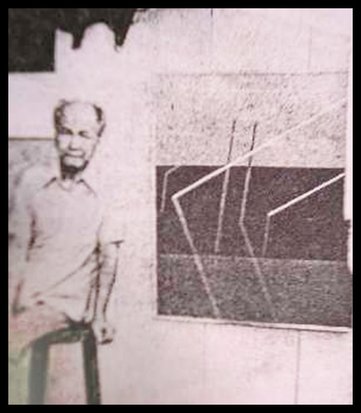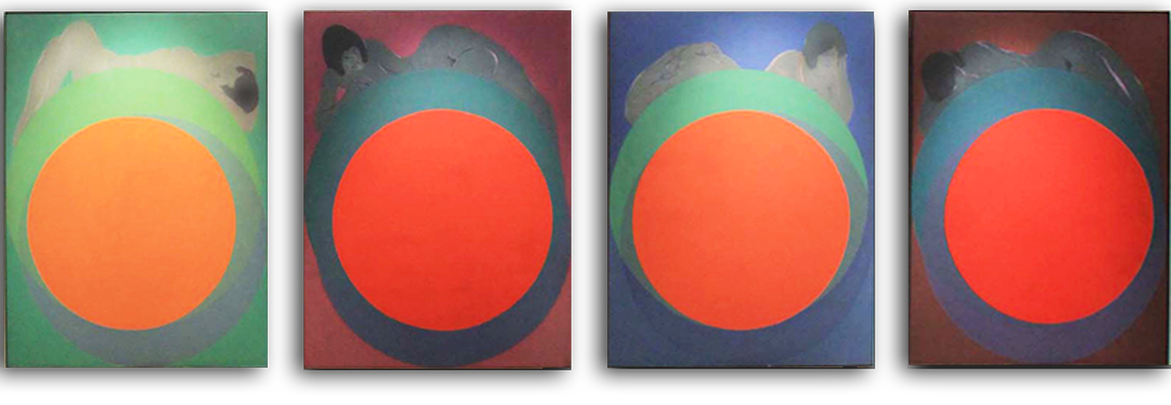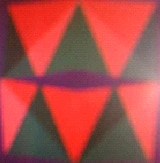PAINTINGS ILLUSTRATIVE OF THE
|
He joined the UP School of Fine Arts in 1947 as faculty even as he was finishing his Bachelor of FA in U.P. 1948. He became Secretary and later Assistant Dean of the UP SFA, later College. He retired at mandatory age in 1978, after nearly 32 years of service in the State University.
|
About the Artist: CMaBernardo was born on December 22, 1913 in Obando, Bulacan. He early on was orphaned of his father Pedro Ma. Bernardo who had married an equally lone child, Cecilia Anastacio. His wife is Nieves H. de Guzman (b. May 10, 1911 d. May 6, 2004) with children Diego Angelo, Rodino Leopoldo and Constancio Leo (Jr.). He finished his 2-year course of Diploma in Painting in an exasperating 7 years due to family financial difficulty. He joined the UP School of Fine Arts in 1947 as faculty even as he was finishing his Bachelor of FA in U.P. 1948. Then he was recommended by Fernando Amorsolo for a U.P. Fellowship and a Fulbright Travel Grant to Yale University in New Haven, Connecticut (1948-1952) earning in one year the Yale 3-year Course Certificate in Painting in 1949; then finished in 2.5 years the 4-year BFA 1951 as primi honoris; and in 1.5 years the 2-year Master of FA 1952 as secundi honoris. From there he went on for nearly half a year of European study tour of museums and art centers. He became Secretary and later Assistant Dean of the UP SFA, later College. He retired at mandatory age in 1978, after nearly 32 years of service in the State University. But he never retired from his art. He died on August 8, 2003, still intent on a project.
|
Father of Philippine Op Art: Anent the Artist’s last living exhibits, Andrew Magsambol writes of “The Father of RP Op Art” in Business World (Oct. 19, 1989, 20). And then Preciosa Subilo writes of “Father of Op art plays with colors and feelings” in Business World (Nov. 20, 1990, 20). The earliest art critic to attribute Op to CMaBernardo’s art is Eric Torres in his article “Painter Bernardo His Op Art – Then and Now” in Manila Times, (Feb. 12, 1966, 11). And then The First National Art Festival brochure (Mar. 29 to Apr. 2, 1966 in Baguio) has this… “Op art in the Philippines is as old as 1952” (alluding to “Perpetual Motion”, done actually in 1950 as written on its verso as “1950/1980”). No byline appears on the brochure. But the one for the 103-piece 1969 Retrospective in Baguio (coming right after the Fourth National Arts Festival that summer) written by art critic and poet Ricaredo Demetillo has no mention of Op (that is to say, if it were the Artist’s self-attribution his friend Dick would have echoed that). In 1972, art critic Ray Albano has this to say on the matter: “Viewed from the body of abstract works he has done in the early 50’s and those done recently, it is doubtless clear that Bernardo’s intention in his paintings is consistent and logical. He has developed an eye that looks at the ‘optical phenomena’ of things, and constructs them, by their qualities, to interesting visual effects.” [- “Abstract Paintings Re-Introduced” The Manila Chronicle (Jan. 23, 1972), 12]. Albano had visited the studio. The 1978 IMF brochure “Insights into Philippine Contemporary Art: A Collection of 53 paintings and sculpture. International Monetary Fund Art Exhibit ...” has this passage by Alice Guillermo… “Representing the hard-edge style of op is an unusual piece by Constancio Bernardo….” (p. 7). |
The Artist in his studio in 1983
[As published in Barbara Mae Dacanay’s “Constancio Bernardo: Evergreen in Isolation”, Celebrity (June-July 1983) 54-57 with unlabeled images of “Perpetual Motion” or P.M. to his right (cropped) and P.M. No. 5 to his left. |
|
About Op Art: In the West, this movement started with artist Victor Vasarely (d. 1997), considered as the Grandfather of Op Art with early works “Etudes Bauhaus” (1929), “The Chess Board” (1935) and “Zebra” (1937). A post-war revival came, e.g. “Meandres Belle-Arts” (1951). About 1960’s, this movement reached the Philippine art scene but its local practitioners at that time had no lasting tag (whether self-declared or critics-imposed). Globally, this movement had been a short-lived one ending at the end of decade 1970’s (even though it persisted for some time in limited circles).
Op Color Interaction (aka Red-Blue Interaction) AC-0960, 1971 Acrylic on Plywood, 94 x 63 cm
Notes on the red-blue: Above is reproduced in Manuel Duldulao’s Contemporary Philippine Art, Q.C.: Vera-Reyes 1972 (p. 174) as Plate 176 and titled there as “Op Color Interaction”. (On the same page is P.M.).
A transparency slide of this piece (blurred with age) has an early label of “Structural Abstraction No. 14”; its original title says it belonged to a series with at least 14 pieces. (It is the only survivor of that series). Solos at Luz Gallery [LG]: This 1971 piece must have been exhibited in any of his One-Man shows at the said same venue - practically The Gallery of that time- during the first half of the 1970’s (unfortunately no catalogue is available for any); namely: in 1971 (“Constancio Bernardo” Sept. 27- Oct 12); in 1972 (“One-man Show” Aug. 11-29); in 1973 two Solos in the same venue (“Retrospective Exhibition of Paintings” Apr. 23 - May 12 and “Exhibition of Paintings” Sept. 27 - Oct. 16); in 1974 (“Exhibition of Paintings” with only the opening date Feb. 23 known) and in late 1975 (ND available except a clue from LG Aug. 25, 1975 letter: “May I remind you of your show late this year?”). “Op Color Interaction” No. 1 and No. 2 appear in the LG Withdrawal Report of Feb. 2, 1974 with one of them having been sold (no trace of it now). Most probably this was in regard to the second LG Solo for that year of 1973. Indeed, before that, in 1972 it had been photographed for the said book, “Courtesy of The [sic] Luz Gallery”. But in 1975, in response to a solicitation by an outfit called Dictionary of International Biography, CMaBernardo listed an “Op Ensemble No. 1” (1971) as one of his six Major Works (lifetime as of that year). He, however, changed his mind about submitting his biography (the fee, the fee) as written for him by his son (yours truly). There is no image and trace of this if a different piece. It is likely to be one and the same, with different titles attached to a common Op.
|






